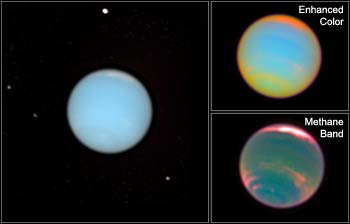The Hubble Space telescope used 14 different color filters to dig out the details of different layers in Neptune’s atmosphere, showing the haze and clouds in considerable detail, and producing a time-lapse movie that has now been released on the Internet. In the image below (click to enlarge), a natural color view of Neptune appears on the left; the familiar blue-green of the atmosphere is the result of absorption by methane of the red wavelengths striking the planet.
At upper right is an enhanced color view. But now check the view at bottom right, taken using methane filters that bring out details above the bulk of the atmospheric methane. At these wavelengths, the planet appears much darker and the long exposure times this permits help to reveal some of Neptune’s smaller moons. You can see these in the natural color image, which is a composite of images in green, red and blue light.
Clockwise from the top, Proteus is the brightest moon; the others are Larissa, Despina and Galatea. Neptune’s known moons total 13. The length of the Neptunian day is between 14 and 19 hours; the Hubble images (made on April 29 and 30 of this year) were taken every four to five hours, thus spacing them at about a quarter of the planet’s rotational period.
Image credit: NASA, ESA, E. Karkoschka (University of Arizona), and H.B. Hammel (Space Science Institute, Boulder, Colorado).



Wow! Was this really the 2nd post?